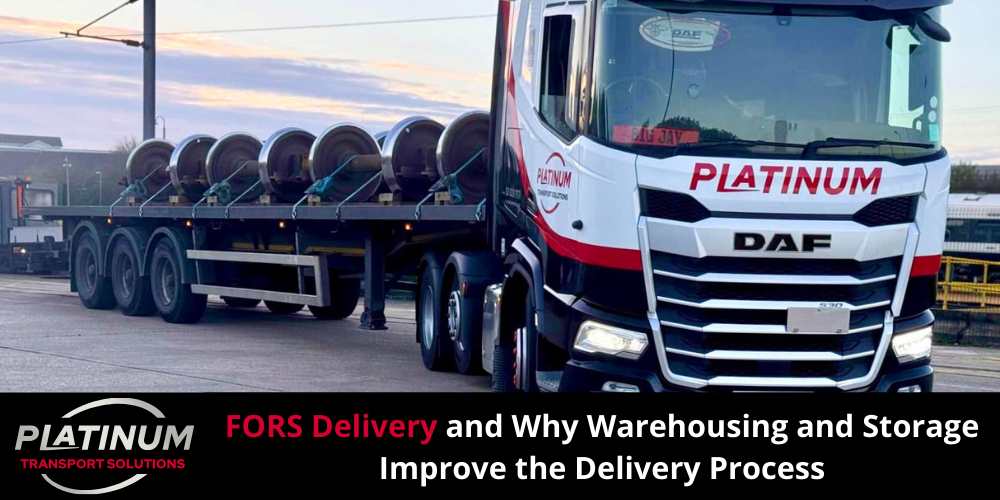
FORS Delivery and Why Warehousing and Storage Improve the Delivery Process
Delivery processes in today’s fast-paced logistics environment are crucial to customer satisfaction and business success. FORS delivery standards ensure that there are always high safety, environmental standards, and operations standards in logistics operations. Strategic warehousing also adds much value in optimising delivery efficiency, offering affordable solutions, and smoothing out delivery from storage.
This article considers how FORS delivery standards and strategic warehousing come into play in raising the delivery processes.
What is FORS Delivery?
Fleet Operator Recognition Scheme accreditation, better known as FORS, helps fleet operators enhance safety, reduce environmental impact, and boost operational efficiencies. Companies accredited under FORS adhere strictly to rules that guarantee compliance with industry standards, including good practices in safe driving, low emission levels, and proper fleet management.
As logistics providers, FORS accreditation signifies a commitment to high standards that build trust between their business and stakeholders. Compliance with FORS standards enhances delivery quality, creates positive brand imagery, and raises customer satisfaction.
The Role of Warehousing and Storage in Delivery
Storage and warehouses are essential for assisting and improving the process of delivery. They focus on providing a central place to manage and efficiently distribute products to reduce lead times and make it easier to run operations. Here are the most critical ways warehouses and storage can positively affect the speed of delivery.

Inventory Management and Accessibility
An efficient inventory management process in warehousing is crucial to ensure the highest stock levels and access to the product. Modern inventory systems provide live real-time monitoring, reducing the risk of stockouts and excess stocking, which could result in cost-intensive expenses.
Automated devices like barcode scanning and RFID technology increase the precision of tracking inventory movements. Warehouses can react rapidly to changes in demand, make informed decisions about restocking, and streamline the supply chain.
By improving these procedures, warehouses can improve delivery time and quicker turnaround times, leading to better customer satisfaction. Today’s market is highly competitive, and efficient inventory management is essential to building solid reputations and customer loyalty.
Faster Order Fulfilment
Warehousing is crucial to improving the effectiveness and reliability of fulfilment. If inventory is close to key demand locations, companies can cut down on processing and delivery times, which is crucial for fulfiling customer demands.
The proximity to the end users reduces the lead time and allows prompt responses to market fluctuations. It allows for agile inventory management and prompt stock replenishment, improving customer experience and increasing efficiency.
Furthermore, organised warehousing could increase order processing efficiency by decreasing packing and picking mistakes. Building a warehouse system leads to an efficient supply chain and fosters customer loyalty.
Reduced Delivery Costs
Centralised warehouses reduce logistics expenses by consolidating shipments and improving the route’s effectiveness. With warehouses close to major transportation routes or essential customer bases, businesses minimize fuel usage, vehicle delivery, and maintenance costs. It can lead to efficient deliveries and improve the speed of service and reliability, thereby increasing customer satisfaction. With reduced transportation costs, companies can transfer savings onto clients, resulting in an ideal win-win scenario that promotes the sustainability and profitability of a logistics system.
Scalability and Flexibility
Warehouse facilities let businesses increase or decrease their operations based on demand. When the seasons are busy, companies can improve their inventory without worrying about space constraints. Additionally, warehousing systems provide flexibility for managing bulk orders, returns, and different products and make the whole supply chain more flexible to the changing market.
Improved Safety and Security
Warehouses are built to guard items from destruction, theft, and environmental risks. Through strict security protocols, warehouses warrant the safety of items, thus minimizing the chances of injuries and damages during transportation. Increased protection is essential when dealing with fragile or expensive objects, which helps maintain high-quality products and customer trust.
Enhanced Route Planning and Optimization
Logistics operations rely on strong partnerships among suppliers, transportation companies, and warehouse providers for effective collaboration and resource sharing. Such collaboration allows organisations to access external expertise while sharing resources across the supply chain. Trust and open dialogue help ensure successful partnerships, which enable logistics managers to negotiate better rates while increasing service levels and operational flexibility quickly.
Companies can increase delivery efficiency by strategically situating warehouse and storage facilities near crucial delivery areas. It helps optimise route planning, allowing drivers to complete more deliveries faster while decreasing fuel usage and increasing delivery speed. Urban environments where traffic congestion impedes schedules may benefit most from such an approach, where companies can adjust their delivery strategies with real-time data analytics to guarantee timely arrivals and enhance customer satisfaction, leading to tremendous operational success overall.
Conclusion
When combined with effective warehousing and storage strategies, FORS delivery provides a robust framework to improve delivery operations. By adopting FORS standards, companies pledge high safety and efficiency standards that foster trust and reliability with customers and employees. Warehousing assists this effort through inventory control solutions that promote faster order fulfilment at reduced costs while offering safer storage solutions. These elements streamline delivery operations, leading to customer delight and more robust business performance.
By teaming with a FORS-accredited delivery provider that utilizes strategic warehousing and storage facilities, businesses can meet the challenges of today’s fast-paced logistics environment while guaranteeing efficient deliveries every time.
